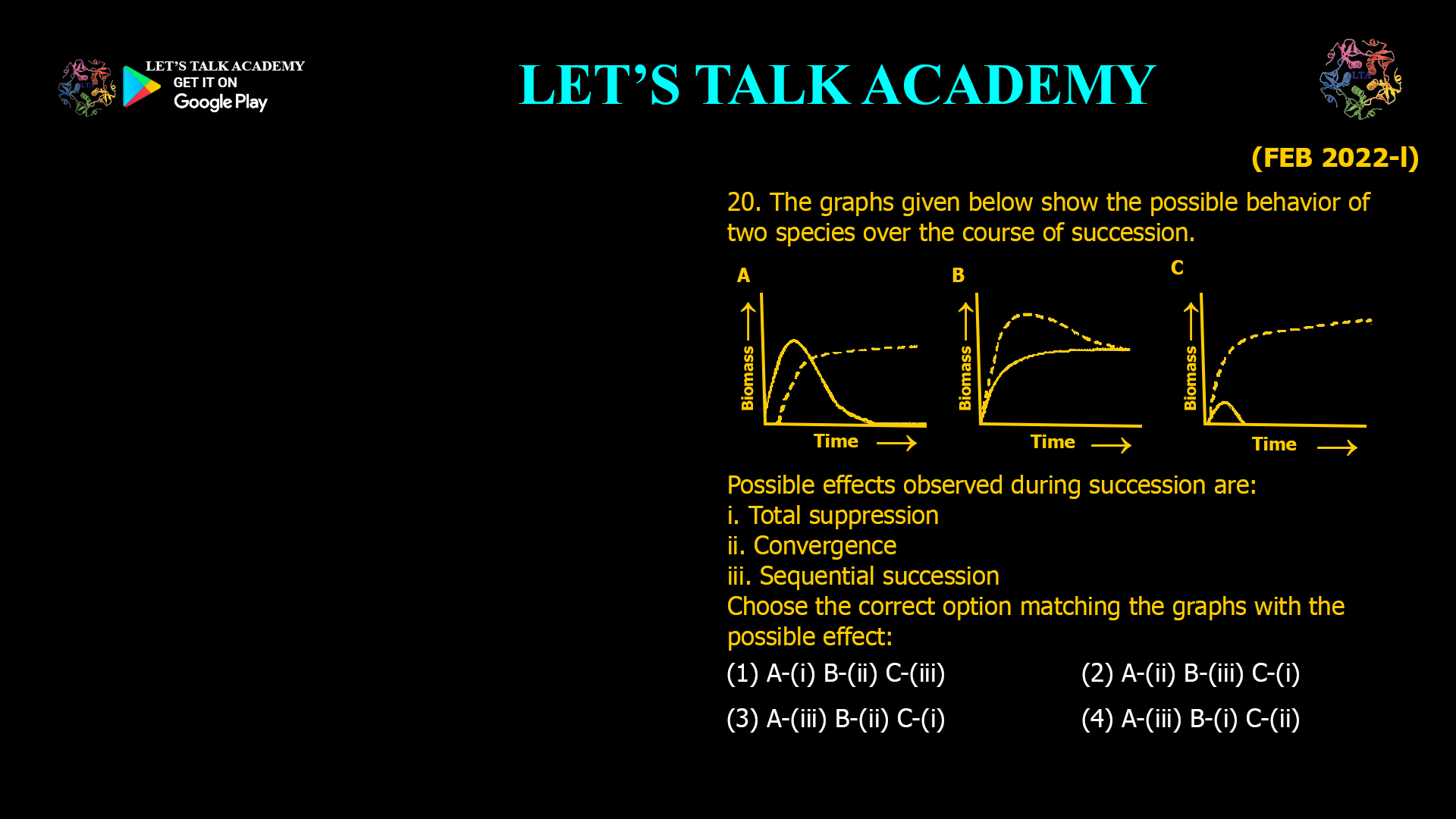- The graphs given below show the possible behavior of two species over the course of succession.
Possible effects observed during succession are:
i. Total suppression
ii. Convergence
iii. Sequential succession
Choose the correct option matching the graphs with the possible effect:
(1) A-(i) B-(ii) C-(iii) (2) A-(ii) B-(iii) C-(i)
(3) A-(iii) B-(ii) C-(i) (4) A-(iii) B-(i) C-(ii)Introduction
Ecological succession is the process by which the species composition of a biological community changes over time, often following a disturbance or environmental change123. The behavior of species during succession can be visualized using graphs that show how their abundances change relative to one another. Understanding how to interpret these graphs is essential for ecologists, conservationists, and students of environmental science. This article explains the possible effects observed during succession—total suppression, convergence, and sequential succession—and matches them to hypothetical graphs A, B, and C, providing a clear guide to interpreting species dynamics in succession.
Key Concepts in Ecological Succession
Ecological succession is driven by interactions between species and their environment, leading to changes in community composition over time567. The process can be influenced by competition, facilitation, and environmental conditions, resulting in different patterns of species replacement and coexistence.
Defining the Effects
1. Total Suppression
Total suppression occurs when one species completely outcompetes and suppresses another, leading to the disappearance of the suppressed species over time. On a graph, this would appear as one species increasing in abundance while the other decreases to zero.
2. Convergence
Convergence refers to the process by which two species become more similar in abundance or dominance as succession progresses. This can happen due to stabilizing forces or environmental filtering. On a graph, the lines representing the two species would move closer together over time.
3. Sequential Succession
Sequential succession describes a clear, stepwise replacement of one species by another. There is little or no overlap in dominance at any given stage. On a graph, one species would decline as another increases, with a clear transition point.
Matching Graphs to Effects
Given hypothetical graphs A, B, and C, the most logical assignments based on standard definitions are:
-
A: Sequential succession (iii)
-
B: Convergence (ii)
-
C: Total suppression (i)
This matches option (3): A-(iii) B-(ii) C-(i).
Why This Matching Makes Sense
-
Sequential succession (A):
This pattern is common in early stages of succession, where pioneer species are replaced by later successional species in a clear sequence. -
Convergence (B):
As the community matures, some species may converge in abundance due to similar environmental tolerances or stabilizing interactions. -
Total suppression (C):
In cases of strong competition or allelopathy, one species may completely suppress another, leading to its disappearance from the community.
Ecological Implications
Understanding these patterns helps ecologists predict how communities will respond to disturbances, manage restoration projects, and conserve biodiversity. Sequential succession is typical in primary and secondary succession, while convergence and suppression highlight the role of species interactions in shaping community structure567.
Common Misconceptions
A common misconception is that all species replacement in succession is due to competition or suppression. In reality, facilitation, convergence, and sequential replacement all play important roles, and the patterns observed depend on the specific species and environmental conditions involved.
Conclusion
When matching graphs of species behavior during succession to the effects of total suppression, convergence, and sequential succession, the most logical and standard assignment is:
A-(iii) B-(ii) C-(i)
This option correctly matches sequential succession, convergence, and total suppression to their respective graph patterns, providing a clear framework for understanding species dynamics in ecological succession.
-




6 Comments
Kirti Agarwal
October 21, 2025A= sequential succession
B= convergence
C= Total suppression
Santosh Saini
October 26, 2025A= Sequential succession , B = convergence , C = total suppression , so option 3( A= 3 , B = 2 , C = 1
Prena Ghangas
October 29, 2025A-(iii) B-(ii) C-(i)
Kajal
November 10, 2025Option 3 is correct
Sakshi Kanwar
November 27, 2025A Sequential succession (iii)
B Convergence (ii)
C Total suppression (i)
option (3): A-(iii) B-(ii) C-(i).
Neelam Sharma
November 28, 2025A= Sequential succession , B = convergence , C = total suppression , so option 3( A= 3 , B = 2 , C = 1